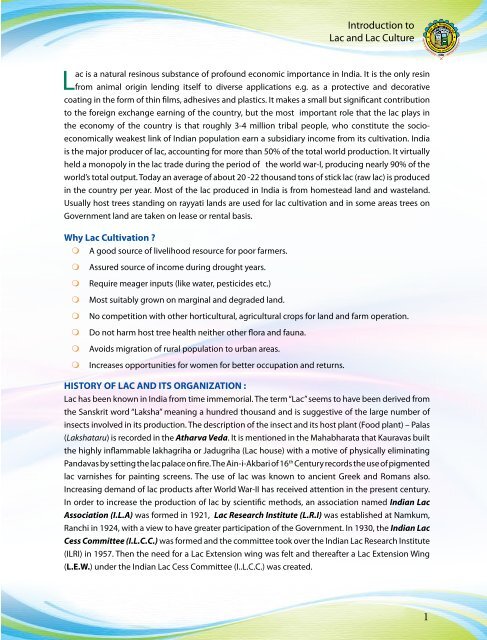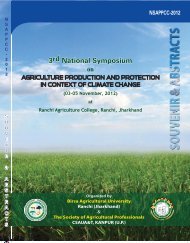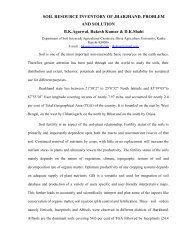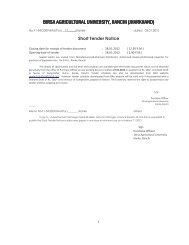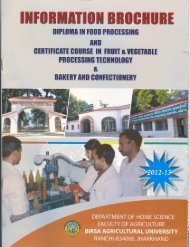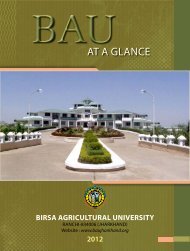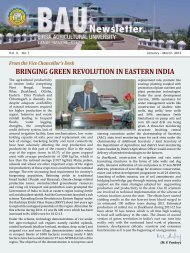Introduction to Lac and Lac Culture - Birsa Agricultural University
Introduction to Lac and Lac Culture - Birsa Agricultural University
Introduction to Lac and Lac Culture - Birsa Agricultural University
Create successful ePaper yourself
Turn your PDF publications into a flip-book with our unique Google optimized e-Paper software.
<strong>Introduction</strong> <strong>to</strong><br />
<strong>Lac</strong> <strong>and</strong> <strong>Lac</strong> <strong>Culture</strong><br />
<strong>Lac</strong> is a natural resinous substance of profound economic importance in India. It is the only resin<br />
from animal origin lending itself <strong>to</strong> diverse applications e.g. as a protective <strong>and</strong> decorative<br />
coating in the form of thin films, adhesives <strong>and</strong> plastics. It makes a small but significant contribution<br />
<strong>to</strong> the foreign exchange earning of the country, but the most important role that the lac plays in<br />
the economy of the country is that roughly 3-4 million tribal people, who constitute the socioeconomically<br />
weakest link of Indian population earn a subsidiary income from its cultivation. India<br />
is the major producer of lac, accounting for more than 50% of the <strong>to</strong>tal world production. It virtually<br />
held a monopoly in the lac trade during the period of the world war-I, producing nearly 90% of the<br />
world’s <strong>to</strong>tal output. Today an average of about 20 -22 thous<strong>and</strong> <strong>to</strong>ns of stick lac (raw lac) is produced<br />
in the country per year. Most of the lac produced in India is from homestead l<strong>and</strong> <strong>and</strong> wastel<strong>and</strong>.<br />
Usually host trees st<strong>and</strong>ing on rayyati l<strong>and</strong>s are used for lac cultivation <strong>and</strong> in some areas trees on<br />
Government l<strong>and</strong> are taken on lease or rental basis.<br />
Why <strong>Lac</strong> Cultivation ?<br />
A good source of livelihood resource for poor farmers.<br />
Assured source of income during drought years.<br />
Require meager inputs (like water, pesticides etc.)<br />
Most suitably grown on marginal <strong>and</strong> degraded l<strong>and</strong>.<br />
No competition with other horticultural, agricultural crops for l<strong>and</strong> <strong>and</strong> farm operation.<br />
Do not harm host tree health neither other flora <strong>and</strong> fauna.<br />
Avoids migration of rural population <strong>to</strong> urban areas.<br />
Increases opportunities for women for better occupation <strong>and</strong> returns.<br />
HISTORY OF LAC AND ITS ORGANIZATION :<br />
<strong>Lac</strong> has been known in India from time immemorial. The term “<strong>Lac</strong>” seems <strong>to</strong> have been derived from<br />
the Sanskrit word “Laksha” meaning a hundred thous<strong>and</strong> <strong>and</strong> is suggestive of the large number of<br />
insects involved in its production. The description of the insect <strong>and</strong> its host plant (Food plant) – Palas<br />
(Lakshataru) is recorded in the Atharva Veda. It is mentioned in the Mahabharata that Kauravas built<br />
the highly inflammable lakhagriha or Jadugriha (<strong>Lac</strong> house) with a motive of physically eliminating<br />
P<strong>and</strong>avas by setting the lac palace on fire. The Ain-i-Akbari of 16th Century records the use of pigmented<br />
lac varnishes for painting screens. The use of lac was known <strong>to</strong> ancient Greek <strong>and</strong> Romans also.<br />
Increasing dem<strong>and</strong> of lac products after World War-II has received attention in the present century.<br />
In order <strong>to</strong> increase the production of lac by scientific methods, an association named Indian <strong>Lac</strong><br />
Association (I.L.A) was formed in 1921, <strong>Lac</strong> Research Institute (L.R.I) was established at Namkum,<br />
Ranchi in 1924, with a view <strong>to</strong> have greater participation of the Government. In 1930, the Indian <strong>Lac</strong><br />
Cess Committee (I.L.C.C.) was formed <strong>and</strong> the committee <strong>to</strong>ok over the Indian <strong>Lac</strong> Research Institute<br />
(ILRI) in 1957. Then the need for a <strong>Lac</strong> Extension wing was felt <strong>and</strong> thereafter a <strong>Lac</strong> Extension Wing<br />
(L.E.W.) under the Indian <strong>Lac</strong> Cess Committee (I..L.C.C.) was created.<br />
1


